Emergency Nursing: Issues, ECG Analysis, GCS, and Interpretation
VerifiedAdded on 2022/08/08
|8
|1282
|51
Homework Assignment
AI Summary
This assignment solution addresses key issues in emergency nursing, focusing on workplace violence and high exposure to traumatic injuries. It explores the challenges faced by emergency nurses, including the psychological impact of their work environment and the limitations of the Glasgow Coma Scale (GCS). The assignment includes interpretations of ECG strips, covering topics like ventricular diastole, automaticity, and refractory periods. It also analyzes ECG readings to identify normal and abnormal heart rhythms, including interpretations of PR intervals, QRS durations, and QT intervals. The solution references several sources to support its claims and provide a comprehensive understanding of the topic.
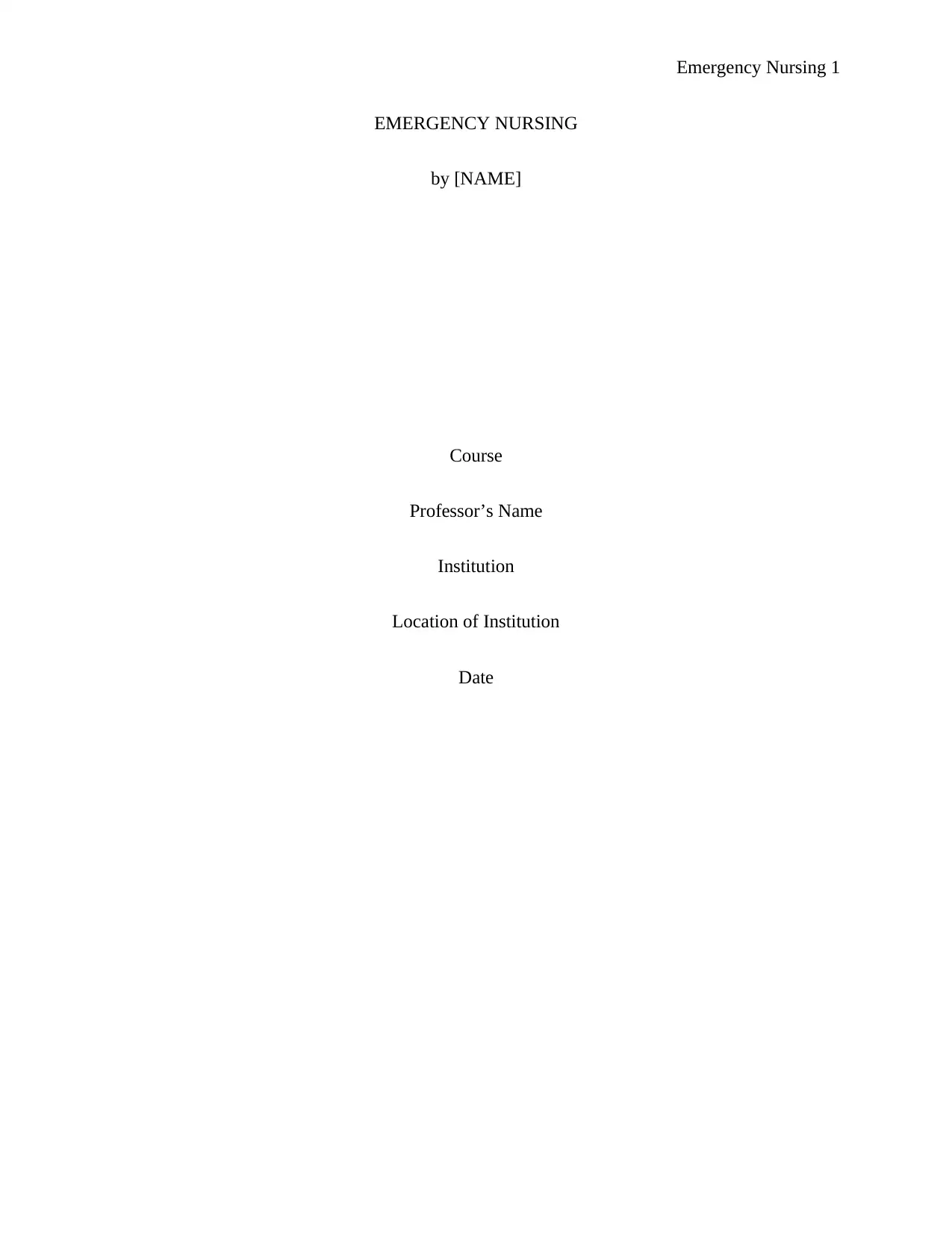
Emergency Nursing 1
EMERGENCY NURSING
by [NAME]
Course
Professor’s Name
Institution
Location of Institution
Date
EMERGENCY NURSING
by [NAME]
Course
Professor’s Name
Institution
Location of Institution
Date
Paraphrase This Document
Need a fresh take? Get an instant paraphrase of this document with our AI Paraphraser
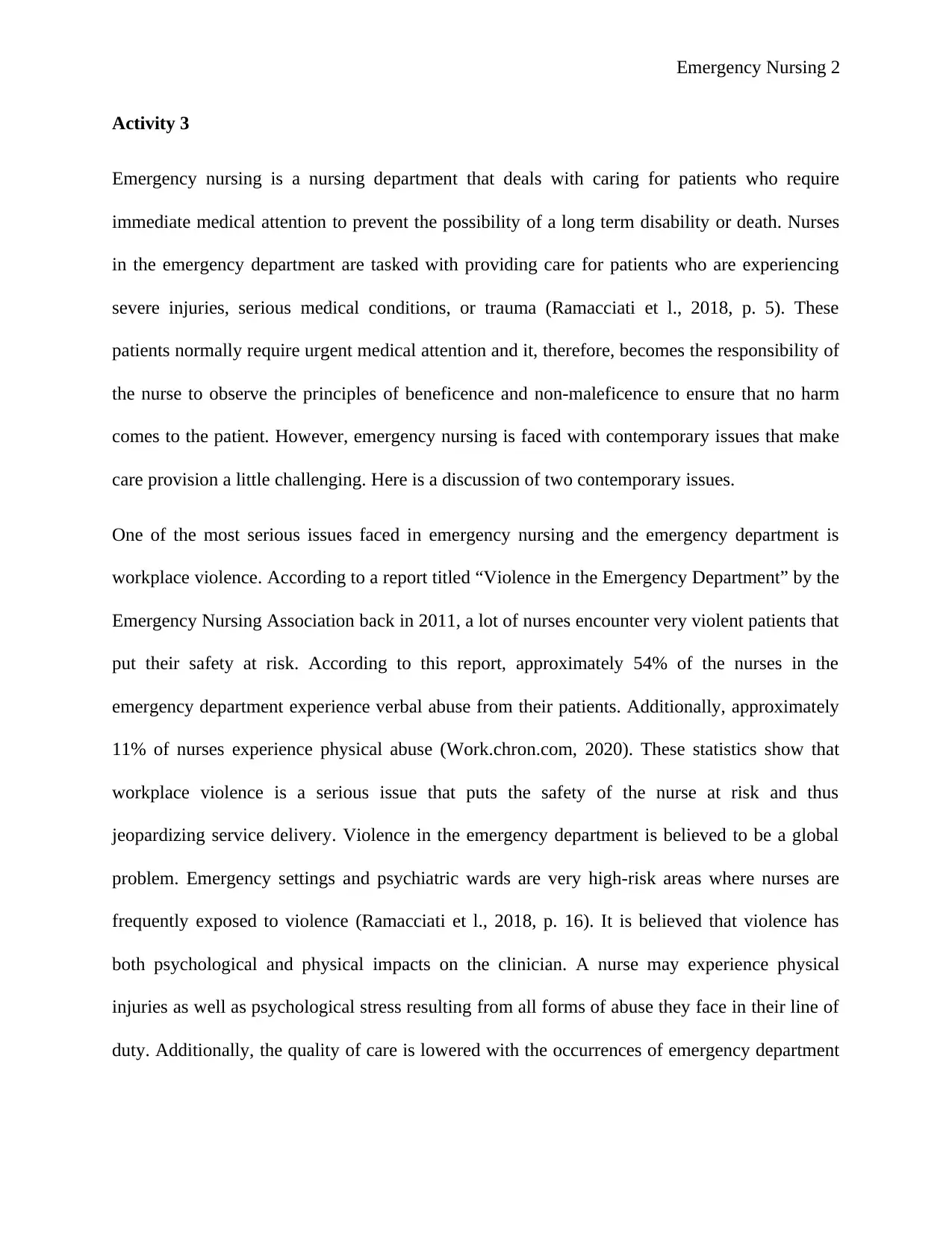
Emergency Nursing 2
Activity 3
Emergency nursing is a nursing department that deals with caring for patients who require
immediate medical attention to prevent the possibility of a long term disability or death. Nurses
in the emergency department are tasked with providing care for patients who are experiencing
severe injuries, serious medical conditions, or trauma (Ramacciati et l., 2018, p. 5). These
patients normally require urgent medical attention and it, therefore, becomes the responsibility of
the nurse to observe the principles of beneficence and non-maleficence to ensure that no harm
comes to the patient. However, emergency nursing is faced with contemporary issues that make
care provision a little challenging. Here is a discussion of two contemporary issues.
One of the most serious issues faced in emergency nursing and the emergency department is
workplace violence. According to a report titled “Violence in the Emergency Department” by the
Emergency Nursing Association back in 2011, a lot of nurses encounter very violent patients that
put their safety at risk. According to this report, approximately 54% of the nurses in the
emergency department experience verbal abuse from their patients. Additionally, approximately
11% of nurses experience physical abuse (Work.chron.com, 2020). These statistics show that
workplace violence is a serious issue that puts the safety of the nurse at risk and thus
jeopardizing service delivery. Violence in the emergency department is believed to be a global
problem. Emergency settings and psychiatric wards are very high-risk areas where nurses are
frequently exposed to violence (Ramacciati et l., 2018, p. 16). It is believed that violence has
both psychological and physical impacts on the clinician. A nurse may experience physical
injuries as well as psychological stress resulting from all forms of abuse they face in their line of
duty. Additionally, the quality of care is lowered with the occurrences of emergency department
Activity 3
Emergency nursing is a nursing department that deals with caring for patients who require
immediate medical attention to prevent the possibility of a long term disability or death. Nurses
in the emergency department are tasked with providing care for patients who are experiencing
severe injuries, serious medical conditions, or trauma (Ramacciati et l., 2018, p. 5). These
patients normally require urgent medical attention and it, therefore, becomes the responsibility of
the nurse to observe the principles of beneficence and non-maleficence to ensure that no harm
comes to the patient. However, emergency nursing is faced with contemporary issues that make
care provision a little challenging. Here is a discussion of two contemporary issues.
One of the most serious issues faced in emergency nursing and the emergency department is
workplace violence. According to a report titled “Violence in the Emergency Department” by the
Emergency Nursing Association back in 2011, a lot of nurses encounter very violent patients that
put their safety at risk. According to this report, approximately 54% of the nurses in the
emergency department experience verbal abuse from their patients. Additionally, approximately
11% of nurses experience physical abuse (Work.chron.com, 2020). These statistics show that
workplace violence is a serious issue that puts the safety of the nurse at risk and thus
jeopardizing service delivery. Violence in the emergency department is believed to be a global
problem. Emergency settings and psychiatric wards are very high-risk areas where nurses are
frequently exposed to violence (Ramacciati et l., 2018, p. 16). It is believed that violence has
both psychological and physical impacts on the clinician. A nurse may experience physical
injuries as well as psychological stress resulting from all forms of abuse they face in their line of
duty. Additionally, the quality of care is lowered with the occurrences of emergency department
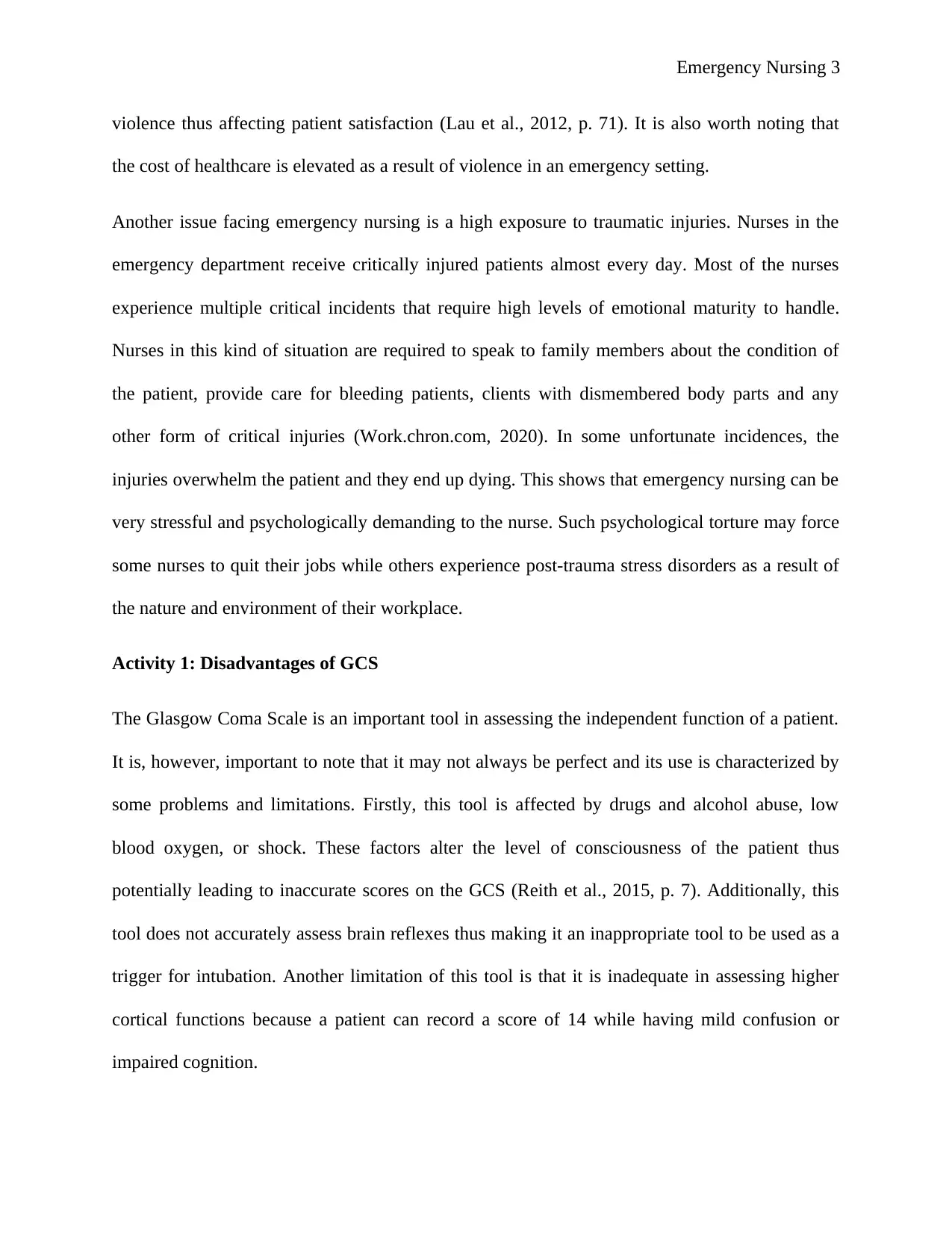
Emergency Nursing 3
violence thus affecting patient satisfaction (Lau et al., 2012, p. 71). It is also worth noting that
the cost of healthcare is elevated as a result of violence in an emergency setting.
Another issue facing emergency nursing is a high exposure to traumatic injuries. Nurses in the
emergency department receive critically injured patients almost every day. Most of the nurses
experience multiple critical incidents that require high levels of emotional maturity to handle.
Nurses in this kind of situation are required to speak to family members about the condition of
the patient, provide care for bleeding patients, clients with dismembered body parts and any
other form of critical injuries (Work.chron.com, 2020). In some unfortunate incidences, the
injuries overwhelm the patient and they end up dying. This shows that emergency nursing can be
very stressful and psychologically demanding to the nurse. Such psychological torture may force
some nurses to quit their jobs while others experience post-trauma stress disorders as a result of
the nature and environment of their workplace.
Activity 1: Disadvantages of GCS
The Glasgow Coma Scale is an important tool in assessing the independent function of a patient.
It is, however, important to note that it may not always be perfect and its use is characterized by
some problems and limitations. Firstly, this tool is affected by drugs and alcohol abuse, low
blood oxygen, or shock. These factors alter the level of consciousness of the patient thus
potentially leading to inaccurate scores on the GCS (Reith et al., 2015, p. 7). Additionally, this
tool does not accurately assess brain reflexes thus making it an inappropriate tool to be used as a
trigger for intubation. Another limitation of this tool is that it is inadequate in assessing higher
cortical functions because a patient can record a score of 14 while having mild confusion or
impaired cognition.
violence thus affecting patient satisfaction (Lau et al., 2012, p. 71). It is also worth noting that
the cost of healthcare is elevated as a result of violence in an emergency setting.
Another issue facing emergency nursing is a high exposure to traumatic injuries. Nurses in the
emergency department receive critically injured patients almost every day. Most of the nurses
experience multiple critical incidents that require high levels of emotional maturity to handle.
Nurses in this kind of situation are required to speak to family members about the condition of
the patient, provide care for bleeding patients, clients with dismembered body parts and any
other form of critical injuries (Work.chron.com, 2020). In some unfortunate incidences, the
injuries overwhelm the patient and they end up dying. This shows that emergency nursing can be
very stressful and psychologically demanding to the nurse. Such psychological torture may force
some nurses to quit their jobs while others experience post-trauma stress disorders as a result of
the nature and environment of their workplace.
Activity 1: Disadvantages of GCS
The Glasgow Coma Scale is an important tool in assessing the independent function of a patient.
It is, however, important to note that it may not always be perfect and its use is characterized by
some problems and limitations. Firstly, this tool is affected by drugs and alcohol abuse, low
blood oxygen, or shock. These factors alter the level of consciousness of the patient thus
potentially leading to inaccurate scores on the GCS (Reith et al., 2015, p. 7). Additionally, this
tool does not accurately assess brain reflexes thus making it an inappropriate tool to be used as a
trigger for intubation. Another limitation of this tool is that it is inadequate in assessing higher
cortical functions because a patient can record a score of 14 while having mild confusion or
impaired cognition.
⊘ This is a preview!⊘
Do you want full access?
Subscribe today to unlock all pages.

Trusted by 1+ million students worldwide
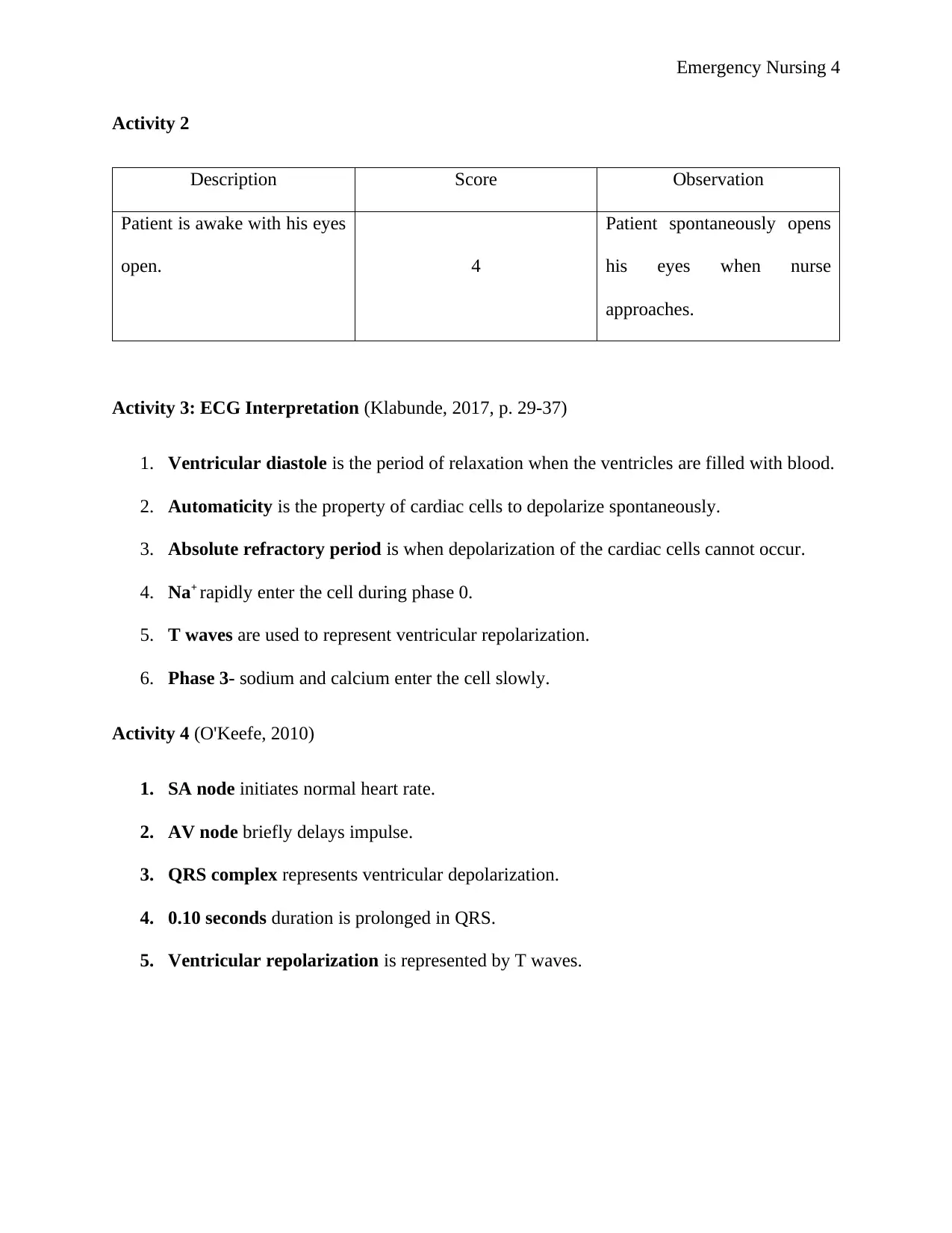
Emergency Nursing 4
Activity 2
Description Score Observation
Patient is awake with his eyes
open. 4
Patient spontaneously opens
his eyes when nurse
approaches.
Activity 3: ECG Interpretation (Klabunde, 2017, p. 29-37)
1. Ventricular diastole is the period of relaxation when the ventricles are filled with blood.
2. Automaticity is the property of cardiac cells to depolarize spontaneously.
3. Absolute refractory period is when depolarization of the cardiac cells cannot occur.
4. Na+ rapidly enter the cell during phase 0.
5. T waves are used to represent ventricular repolarization.
6. Phase 3- sodium and calcium enter the cell slowly.
Activity 4 (O'Keefe, 2010)
1. SA node initiates normal heart rate.
2. AV node briefly delays impulse.
3. QRS complex represents ventricular depolarization.
4. 0.10 seconds duration is prolonged in QRS.
5. Ventricular repolarization is represented by T waves.
Activity 2
Description Score Observation
Patient is awake with his eyes
open. 4
Patient spontaneously opens
his eyes when nurse
approaches.
Activity 3: ECG Interpretation (Klabunde, 2017, p. 29-37)
1. Ventricular diastole is the period of relaxation when the ventricles are filled with blood.
2. Automaticity is the property of cardiac cells to depolarize spontaneously.
3. Absolute refractory period is when depolarization of the cardiac cells cannot occur.
4. Na+ rapidly enter the cell during phase 0.
5. T waves are used to represent ventricular repolarization.
6. Phase 3- sodium and calcium enter the cell slowly.
Activity 4 (O'Keefe, 2010)
1. SA node initiates normal heart rate.
2. AV node briefly delays impulse.
3. QRS complex represents ventricular depolarization.
4. 0.10 seconds duration is prolonged in QRS.
5. Ventricular repolarization is represented by T waves.
Paraphrase This Document
Need a fresh take? Get an instant paraphrase of this document with our AI Paraphraser
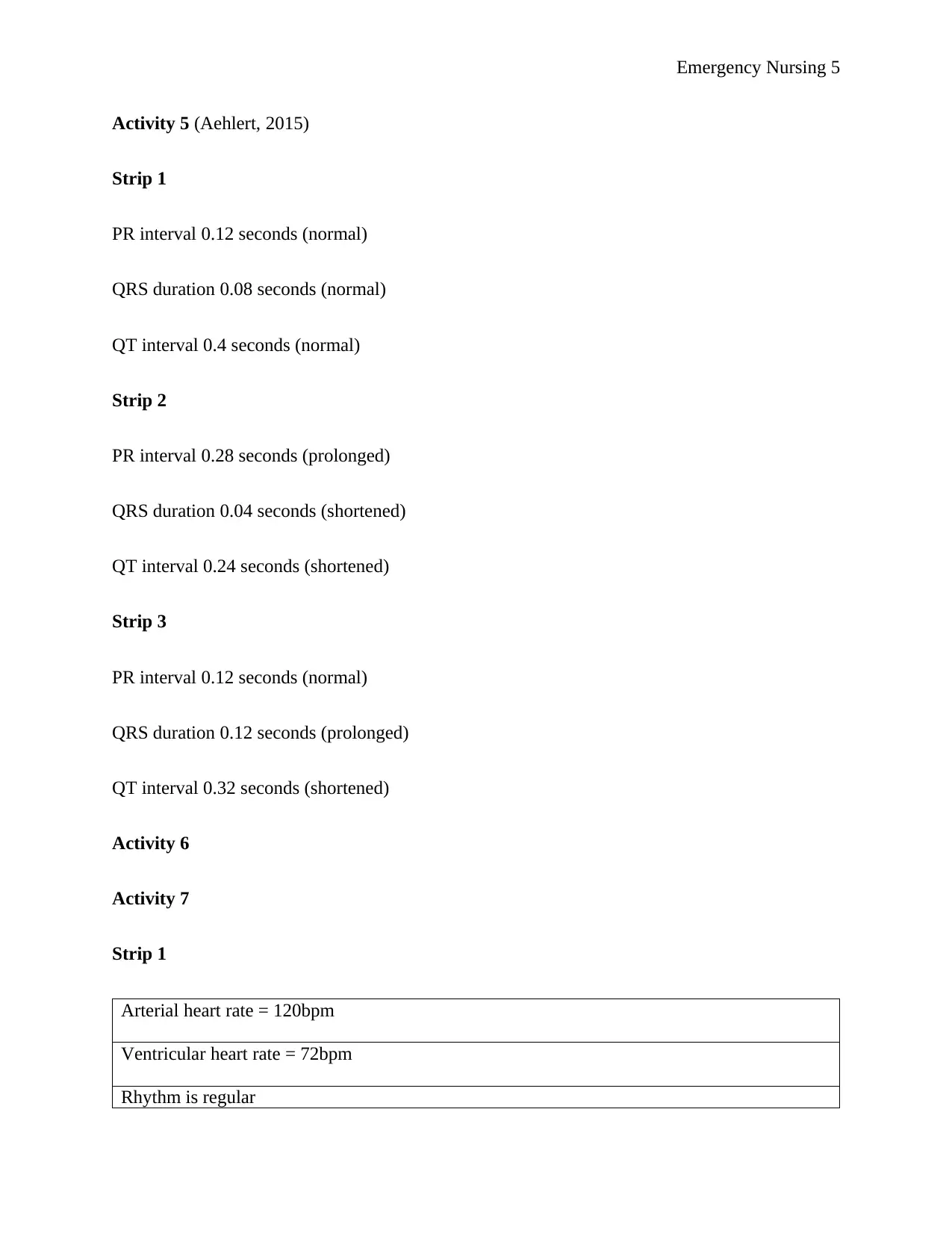
Emergency Nursing 5
Activity 5 (Aehlert, 2015)
Strip 1
PR interval 0.12 seconds (normal)
QRS duration 0.08 seconds (normal)
QT interval 0.4 seconds (normal)
Strip 2
PR interval 0.28 seconds (prolonged)
QRS duration 0.04 seconds (shortened)
QT interval 0.24 seconds (shortened)
Strip 3
PR interval 0.12 seconds (normal)
QRS duration 0.12 seconds (prolonged)
QT interval 0.32 seconds (shortened)
Activity 6
Activity 7
Strip 1
Arterial heart rate = 120bpm
Ventricular heart rate = 72bpm
Rhythm is regular
Activity 5 (Aehlert, 2015)
Strip 1
PR interval 0.12 seconds (normal)
QRS duration 0.08 seconds (normal)
QT interval 0.4 seconds (normal)
Strip 2
PR interval 0.28 seconds (prolonged)
QRS duration 0.04 seconds (shortened)
QT interval 0.24 seconds (shortened)
Strip 3
PR interval 0.12 seconds (normal)
QRS duration 0.12 seconds (prolonged)
QT interval 0.32 seconds (shortened)
Activity 6
Activity 7
Strip 1
Arterial heart rate = 120bpm
Ventricular heart rate = 72bpm
Rhythm is regular
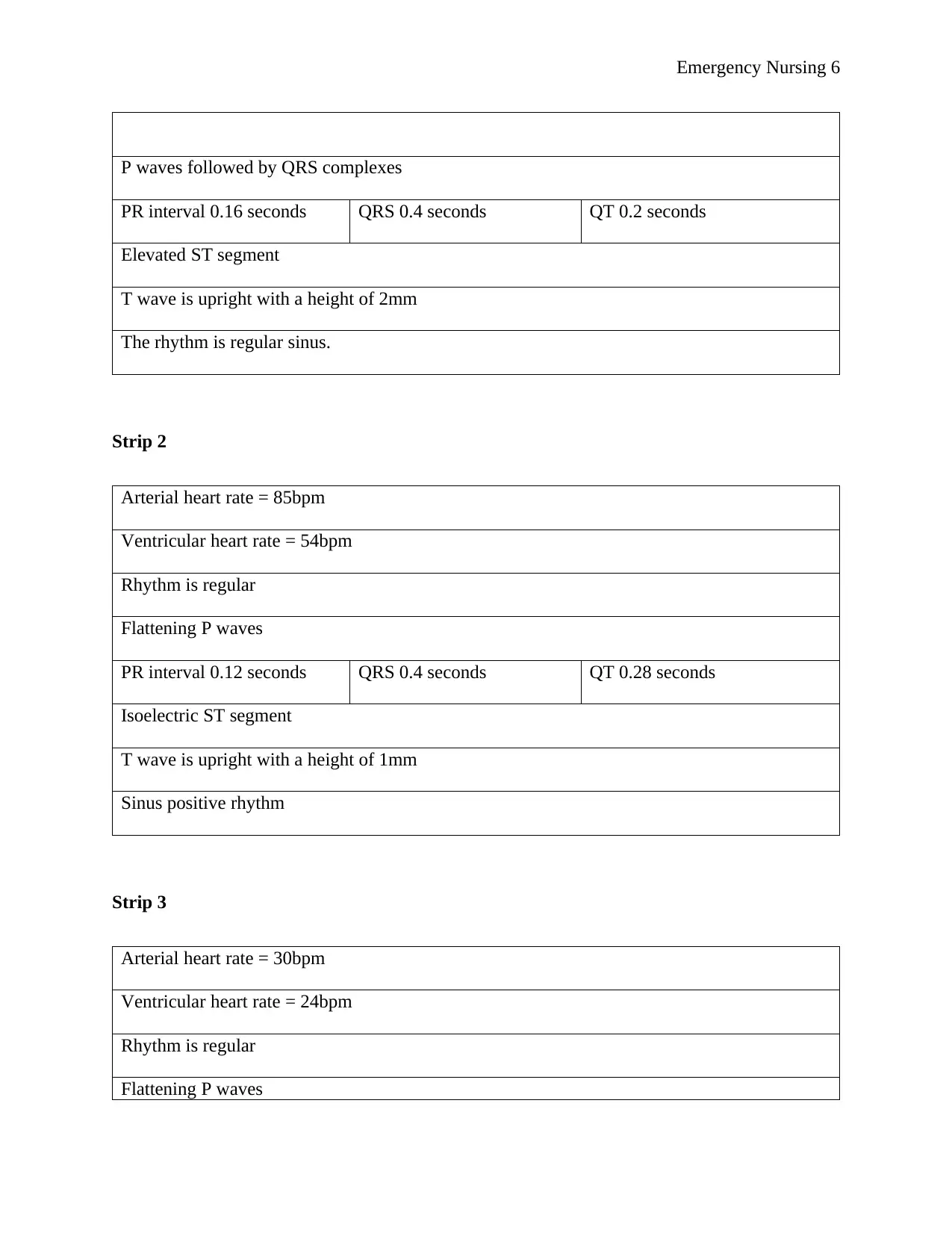
Emergency Nursing 6
P waves followed by QRS complexes
PR interval 0.16 seconds QRS 0.4 seconds QT 0.2 seconds
Elevated ST segment
T wave is upright with a height of 2mm
The rhythm is regular sinus.
Strip 2
Arterial heart rate = 85bpm
Ventricular heart rate = 54bpm
Rhythm is regular
Flattening P waves
PR interval 0.12 seconds QRS 0.4 seconds QT 0.28 seconds
Isoelectric ST segment
T wave is upright with a height of 1mm
Sinus positive rhythm
Strip 3
Arterial heart rate = 30bpm
Ventricular heart rate = 24bpm
Rhythm is regular
Flattening P waves
P waves followed by QRS complexes
PR interval 0.16 seconds QRS 0.4 seconds QT 0.2 seconds
Elevated ST segment
T wave is upright with a height of 2mm
The rhythm is regular sinus.
Strip 2
Arterial heart rate = 85bpm
Ventricular heart rate = 54bpm
Rhythm is regular
Flattening P waves
PR interval 0.12 seconds QRS 0.4 seconds QT 0.28 seconds
Isoelectric ST segment
T wave is upright with a height of 1mm
Sinus positive rhythm
Strip 3
Arterial heart rate = 30bpm
Ventricular heart rate = 24bpm
Rhythm is regular
Flattening P waves
⊘ This is a preview!⊘
Do you want full access?
Subscribe today to unlock all pages.

Trusted by 1+ million students worldwide
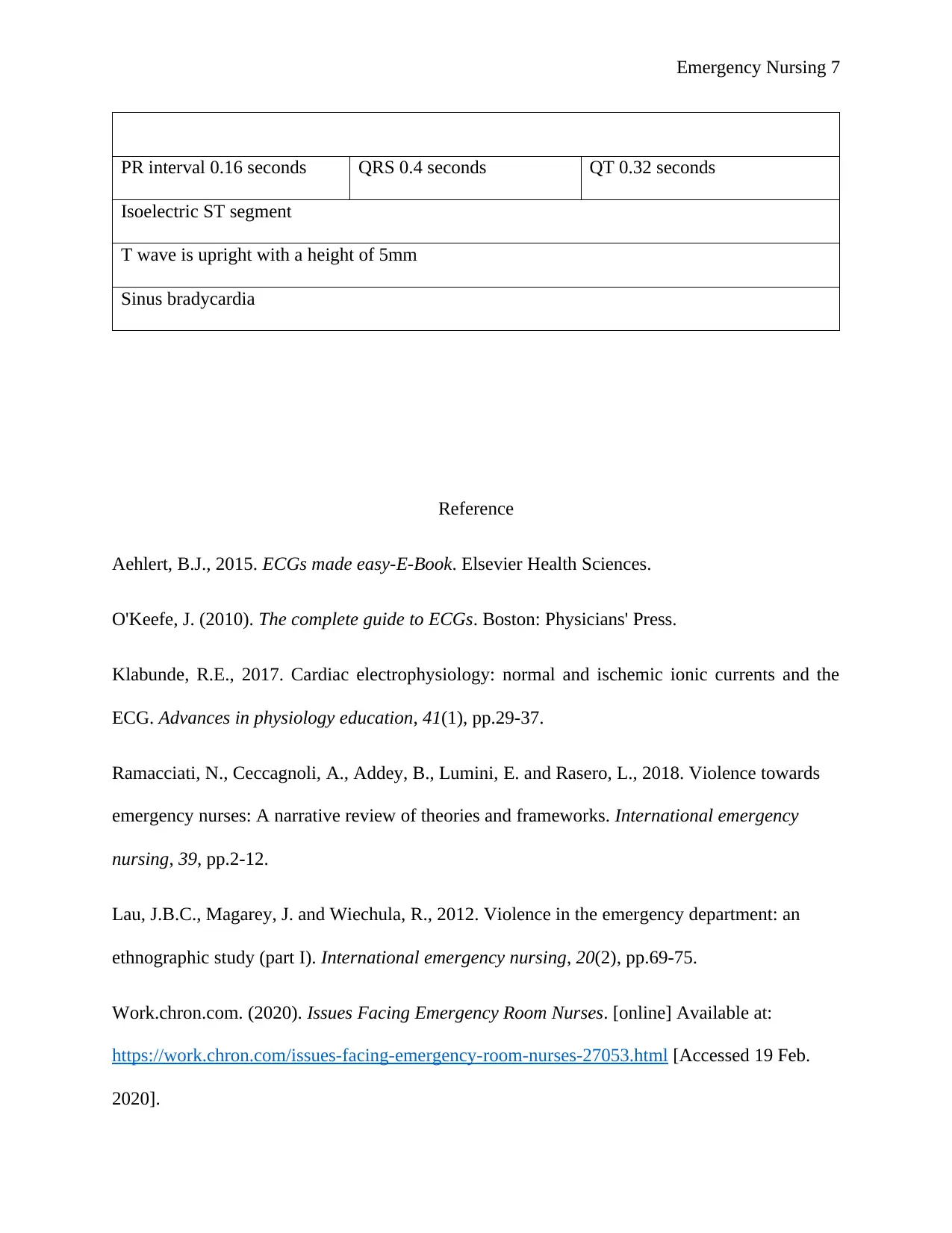
Emergency Nursing 7
PR interval 0.16 seconds QRS 0.4 seconds QT 0.32 seconds
Isoelectric ST segment
T wave is upright with a height of 5mm
Sinus bradycardia
Reference
Aehlert, B.J., 2015. ECGs made easy-E-Book. Elsevier Health Sciences.
O'Keefe, J. (2010). The complete guide to ECGs. Boston: Physicians' Press.
Klabunde, R.E., 2017. Cardiac electrophysiology: normal and ischemic ionic currents and the
ECG. Advances in physiology education, 41(1), pp.29-37.
Ramacciati, N., Ceccagnoli, A., Addey, B., Lumini, E. and Rasero, L., 2018. Violence towards
emergency nurses: A narrative review of theories and frameworks. International emergency
nursing, 39, pp.2-12.
Lau, J.B.C., Magarey, J. and Wiechula, R., 2012. Violence in the emergency department: an
ethnographic study (part I). International emergency nursing, 20(2), pp.69-75.
Work.chron.com. (2020). Issues Facing Emergency Room Nurses. [online] Available at:
https://work.chron.com/issues-facing-emergency-room-nurses-27053.html [Accessed 19 Feb.
2020].
PR interval 0.16 seconds QRS 0.4 seconds QT 0.32 seconds
Isoelectric ST segment
T wave is upright with a height of 5mm
Sinus bradycardia
Reference
Aehlert, B.J., 2015. ECGs made easy-E-Book. Elsevier Health Sciences.
O'Keefe, J. (2010). The complete guide to ECGs. Boston: Physicians' Press.
Klabunde, R.E., 2017. Cardiac electrophysiology: normal and ischemic ionic currents and the
ECG. Advances in physiology education, 41(1), pp.29-37.
Ramacciati, N., Ceccagnoli, A., Addey, B., Lumini, E. and Rasero, L., 2018. Violence towards
emergency nurses: A narrative review of theories and frameworks. International emergency
nursing, 39, pp.2-12.
Lau, J.B.C., Magarey, J. and Wiechula, R., 2012. Violence in the emergency department: an
ethnographic study (part I). International emergency nursing, 20(2), pp.69-75.
Work.chron.com. (2020). Issues Facing Emergency Room Nurses. [online] Available at:
https://work.chron.com/issues-facing-emergency-room-nurses-27053.html [Accessed 19 Feb.
2020].
Paraphrase This Document
Need a fresh take? Get an instant paraphrase of this document with our AI Paraphraser

Emergency Nursing 8
Reith, F.C., Van den Brande, R., Synnot, A., Gruen, R. and Maas, A.I., 2016. The reliability of
the Glasgow Coma Scale: a systematic review. Intensive care medicine, 42(1), pp.3-15.
Reith, F.C., Van den Brande, R., Synnot, A., Gruen, R. and Maas, A.I., 2016. The reliability of
the Glasgow Coma Scale: a systematic review. Intensive care medicine, 42(1), pp.3-15.
1 out of 8
Related Documents
Your All-in-One AI-Powered Toolkit for Academic Success.
+13062052269
info@desklib.com
Available 24*7 on WhatsApp / Email
![[object Object]](/_next/static/media/star-bottom.7253800d.svg)
Unlock your academic potential
Copyright © 2020–2025 A2Z Services. All Rights Reserved. Developed and managed by ZUCOL.





